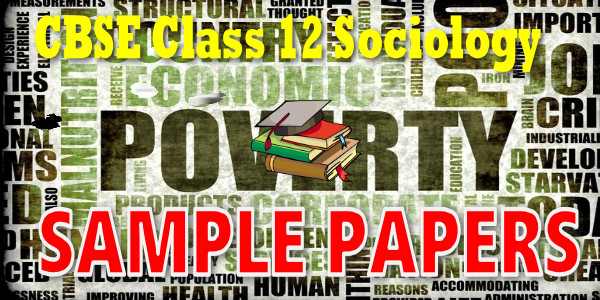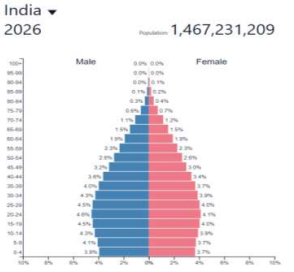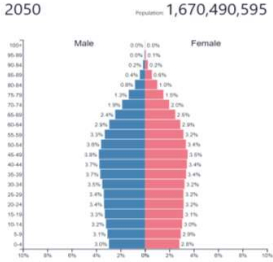
myCBSEguide App
Download the app to get CBSE Sample Papers 2023-24, NCERT Solutions (Revised), Most Important Questions, Previous Year Question Bank, Mock Tests, and Detailed Notes.
Install NowClass 12 Sociology sample paper 2024 has many competency-based questions this year. You can download CBSE Sample Papers Class 12 Sociology 2024 from our mobile app (myCBSEguide) or from the student dashboard.
Sample paper of Sociology Class 12 – in PDF
Let us understand the format of CBSE Sample Papers Class 12 Sociology 2024. It has
Sample Papers of Class 12 Sociology 2024 with solution
CBSE Sample Papers Class 12 Sociology 2024
myCBSEguide provides CBSE class 12 Board Sample Papers of Sociology for the year 2024 with solutions in PDF format for free download. The CBSE Sample Papers for all – NCERT books and based on CBSE’s latest syllabus must be downloaded and practiced by students. Class 12 Sociology New Sample Papers follow the blueprint of that year only. Students must check the latest syllabus and marking scheme. Sample papers for class 12 Sociology and other subjects are available for download as PDF in-app too. myCBSEguide provides sample papers with solutions for the year 2024.

Class 12 Sample Papers Sociology 2024
CBSE Class 12
Sociology (Code No. 039)
(Sample Paper 2023-24)
TIME: 3 HOURS
Maximum Marks: 80
General Instructions
- The question paper is divided into four sections.
- There are 38 questions in all. All questions are compulsory.
- Section A includes question No. 1-20. These are MCQ type questions. As per the question, there can be one answer.
- Section B includes question No.21-29. These are very short answer type questions carrying 2 marks each. Answer to each question should not exceed 30 words.
- Section C includes question No. 30-35. They are short answer type questions carrying 4 marks each. Answer to each question should not exceed 80 words.
- Section D includes question No. 36-38. They are long answer type questions carrying 6 marks each. Answer to each question should not exceed 200 words each. Question no 36 is to be answered with the help of the passage given.
12th Sociology Sample Paper SECTION A
- Assertion (A): Modern industry created all kinds of new jobs for which there were no caste rules.
Reason (R): Urbanisation and the conditions of collective living in the cities made it difficult for caste-segregated patterns of social interaction to survive.- Both A and R are true and R is the correct explanation of A.
- Both A and R are true but R is not the correct explanation of A.
- A is true but R is false.
- A is false and R is true.
- Which of the following stages, as per the Theory of Demographic Transition, is that of high population growth?
- First Stage
- Both first and second stage
- Second Stage
- Third Stage
- Assertion (A): Castes are not only unequal to each other in ritual terms they are also supposed to be complementary and noncompeting groups.
Reason (R): Each caste has its own place in the system which cannot be taken by any other caste.- Both A and R are true and R is the correct explanation of A.
- Both A and R are true but R is not the correct explanation of A.
- A is true but R is false.
- A is false and R is true.
- Which of the following reasons are responsible for the invisibility of the caste
system in the upper castes and upper middle class?- Policy of reservation
- Special Programmes for upper caste
- Both a and b
- Education and Employment in Private Sector
- Assertion (A): By the 1970s all the major definitions of tribe were shown to be
faulty.
Reason (R): It was pointed out that the tribe-peasantry distinctions did not hold in
terms of any of the commonly advanced criteria: size, isolation, religion and means of livelihood.- Both A and R are true and R is the correct explanation of A.
- Both A and R are true but R is not the correct explanation of A.
- A is true but R is false.
- A is false and R is true.
- “Considering from an urban point of view, the rapid growth in urbanization shows that the town or city has been acting as a magnet for the rural population.”
Choose the incorrect statement about urbanization in India?- Rural- to- Urban migration has increased due to decline in common property resources.
- Urban areas are a decisive force in terms of political dynamics.
- People go to cities in search of work.
- Cities offer anonymity to the poor and oppressed class.
- In which ways Advises struggles are different from Dalit struggle?
- They were not discriminated against like the Dalits.
- Their social and economic conditions were better than the Dalits
- They did not face social exclusion like the Dalits.
- Advises were concentrated in contagious areas and could demand statehood
- Stereotypes fix whole groups into single ________ categories, they refuse to recognize the ________ across individuals and across context or across time.
- Homogeneous, variation
- Heterogeneous, similarities
- Broad, similarities
- Diverse, differences
- Cultural diversity can present tough challenges. Which of the following is not a reason for challenge?
- It can arouse intense passions among its members and mobilise large numbers of people
- Economic and social inequalities among the communities.
- Equal distribution of scarce resources- like river water, jobs or
governments funds. - Injustices suffered by one community provoke opposition from same communities.
- Policies promoting integration involve-
- Outright suppression of identities of groups which are in minority.
- Complete erosion of cultural differences between groups.
- Elimination of ethno-national and cultural differences from the public arena.
- All of the above.
- Assertion (A): Urbanisation in the colonial period saw the formation ofnew urban centres.
Reason (R): These urban centres were designed to functions as trading posts
alone.- Both A and R are true and R is the correct explanation of A.
- Both A and R are true but R is not the correct explanation of A.
- A is true but R is false.
- A is false and R is true.
- Assertion (A): The impact of Sanskritisation is many sided.
Reason (R): Its influence can be seen in language, literature, ideology,
music, dance, drama,style of life and ritual.- Both A and R are true and R is the correct explanation of A.
- Both A and R are true but R is not the correct explanation of A.
- A is true but R is false.
- A is false and R is true.
- What is the meaning of the term Begar in the Indian agrarian context?
- Bonded labour
- Free Labour
- Landlords
- Tenant
- Assertion (A): In most of the states, land ceiling act proved to be toothless.
Reason (R): There were many loopholes and most landowners were able to escape from having their surplus land taken over by the state.- Both A and R are true and R is the correct explanation of A.
- Both A and R are true but R is not the correct explanation of A.
- A is true but R is false.
- A is false and R is true.
- Most of the New Year festival in different regions of India such as Pongal in Tamil Nadu, Bihu in Assam, Baisakhi in Punjab and Ugadi in Karnataka to name just a few actually celebrate the main harvest season and herald the beginning of a new agricultural season.
Assertion (A): There is a close connection between agriculture & culture.
Reason (R): Many of our cultural practices and patterns can be traced to our agrarian background.- Both A and R are true and R is the correct explanation of A.
- Both A and R are true but R is not the correct explanation of A.
- A is true but R is false.
- A is false and R is true.
- Assertion (A): The rural in Kerala is a mixed economy.
Reason (R): The economy in Kerala integrates agriculture with a wide network of retail sales and services where a large number of families are dependent on remittances from abroad.- Both A and R are true and R is the correct explanation of A.
- Both A and R are true but R is not the correct explanation of A.
- A is true but R is false.
- A is false and R is true.
- Major difference between developing and developed countries is in the number of people in ________ salaried employment.
- Daily Wages
- Regular
- Irregular
- Both b) & c)
- Many items like paper and wood products, glass and ceramics were reserved for the ________ sector by the government.
- Medium- scale
- Large- scale
- Small- scale
- Both b & c
- Before Independence Industries were located mainly in which types of cities?
- Metropolitan
- Port
- Town
- Urban
- Introduction of machinery such as tillers, tractors, threshers and harvesters led to the ________.
- Displacement of the service castes.
- Greater wages for the service castes.
- Equality in the agrarian structure.
- Low production output.
12th Sociology Sample Paper SECTION-B
- In Modern Foods, which was set up by the government to make healthy bread available at cheap prices, and which was the first company to be privatised, 60% of the workers were forced to retire in the first five years. Based on the given passage, answer the following question. What do you mean by disinvestment? How did disinvestment impact the workers?
(OR)
“In Maruti Udyog Ltd. two cars roll off the assembly line every minute. Workers get only 45 minutes rest in the entire day – two tea breaks of 7.5 minutes each and one lunch break of half an hour. Most of them are exhausted by the age of 40 and take voluntary retirement.” Based upon above passage, answer the following question. What, according to you, is the impact of the factory‟s working condition on the workers and on the factory?
- Why does Jan Breman use the term „footloose‟ for labour?
- What is meant by „Great Tradition?
- With an example show how being a minority group can be disadvantageous in one sense but not in another.
- Westernization gave rise to the formation of a sub-culture of Indian intellectuals. Give two characteristics of this sub-cultural group.
- City offers relative anonymity to those migrating to it. What do you mean by relative anonymity?
- “If hard labour were such a good thing the rich would keep it all for themselves.” Which social phenomena is reflected in this proverb? Give any two characteristics of this phenomena.
- The family is linked to the economic sphere. Highlight the link using any two scenarios.
- Rabindranath Tagore on the evils of exclusive nationalism …where the spirit of the Western nationalism prevails, the whole people is being taught from boyhood to foster hatred and ambitions by all kinds of means — by the manufacture of half-truths and untruths in history, by persistent misrepresentation of other races and the culture of unfavorable sentiments towards them…Never think for a moment that the hurt you inflict upon other races will not infect you, or that the enmities you sow around your homes will be a wall of protection to you for all time to come? To imbue the minds of a whole people with an abnormal vanity of its own superiority, to teach it to take pride in its moral callousness and I”ll be gotten wealth, to perpetuate humiliation of defeated nations by exhibiting trophies won from war, and using these schools in order to breed in children‟s minds contempt for others, is imitating the West where she has a festering sore…
Source: On Nationalism by Rabindranath Tagore. First published in 1917, Reprint Edition of Macmillan, Madras 1930.
Read the passage and show any two ways in which exclusive nationalism is practiced.(OR)
Is statehood always based on linguistic identity? Give reasons for
your answer.
12th Sociology Sample Paper SECTION-C
- Work in the IT sector is also subjected to Taylorist labour processes. Substantiate this statement with a suitable example.
(OR)
“After independence, the government took over the commanding heights of the economy.” What were the initiatives taken by the government to do the same?
- The post independent Indian state‟s caste considerations had some contradictions. Elucidate on these contradictions.
(OR)
Caste system stood for different connotations in different time periods. Do you agree with the given statement? Give reasons for your answer.
- Using an example, show how the treatment of Indian plantation labour was different from the way Colonial administration treated their own labour back home.
- Emile Durkheim and Karl Marx offer two different interpretations of social movements. Explain these two interpretations.
- During a communal conflict, communities construct matching but opposite mirror images of each other. Explain this statement.
- The agrarian structure becomes more unequal with high agricultural productivity. Explain with a suitable example.
12th Sociology Sample Paper SECTION-D


(Source: https://www.populationpyramid.net/india)
Based on the given Population Pyramids of India for the year 2026 and 2050, answer the following questions.- What is demographic dividend?
- What do you infer, on comparing the given graphics for the age group of 55-59 and 60-64?
- What, according to you, are the implications of this inference?
(Q 36. FOR CANDIDATES WITH VISUAL IMPAIRMENT)
- The Population Pyramid of India for the year 2050 indicates that the male and female population in the age range of 60-64 stands at 2.9% and the male and female population in the age range of 55-59 stands at 3.3% and 3.2% respectively.
The Population Pyramid of India for the year 2026 indicates that the male and female population in the age range of 60-64 stands at 1.9% and the male and female population in the age range of 55-59 stands at 2.3%.
Based on this data, answer the following questions.- What is demographic dividend?
- What do you infer, on comparing the given data for the age group of 55-59 and 60-64?
What, according to you, are the implications of this inference?
- Niyamgiri Hills is home to Dongria Kondh, a particularly vulnerable tribal group, who had unanimously voted against a project by state government-owned Odisha Mining Corporation (OMand Sterlite Industries which wanted to mine bauxite. The villages‟ decision followed a landmark Supreme Court verdict on April 18, 2013, that vindicated the decade-long movement. The court said forest clearance for the mining project, which had been withdrawn by the Environment Ministry in 2010, could be given only after taking the consent of the gram sabhas, or village councils, in the region in tandem with the Forest Right Act (FRA).” (Source: Development At Cost Of Human Lives? Revisiting Adivasi Resistance In Mali Parbat, Niyamgiri Hills, Shreya Basak, 19 Jan 2023 12:29 PM, Outlook)
Based on the given passage, answer the following questions.- What is a social movement?
- Based on your reading of the passage, identify the issues that the social movement addresses.
Would you classify this social movement as old or new Give reasons for your answer.
- “It is often assumed that social reform for women‟s rights was entirely fought for by male reformers and that ideas of women‟s equality are alien imports.” Is this true or false? Give reasons for your answer.
These are questions only. To view and download the complete question paper with the solution install the myCBSEguide App from Google Play Store or log in to our student dashboard.
Class 12 Sample Papers 2024
- Physics
- Chemistry
- Mathematics
- Biology
- English Core
- Business Studies
- Economics
- Accountancy
- Computer Science
- Informatics Practices
- Hindi Core
- Hindi Elective
- History
- Political Science
- Geography
- Home Science
- Physical Education
- Other Subjects
To download sample papers for class 12 Physics, Chemistry, Biology, History, Political Science, Economics, Geography, Computer Science, Home Science, Accountancy, Business Studies and Home Science; do check the myCBSEguide app or website. myCBSEguide provides sample papers with solutions, test papers for chapter-wise practice, NCERT solutions, NCERT Exemplar solutions, quick revision notes for ready reference, CBSE guess papers and CBSE important question papers. Sample Papers all are made available through the best app for CBSE students and the myCBSEguide website.

Test Generator
Create question paper PDF and online tests with your own name & logo in minutes.
Create Now
myCBSEguide
Question Bank, Mock Tests, Exam Papers, NCERT Solutions, Sample Papers, Notes
Install Now